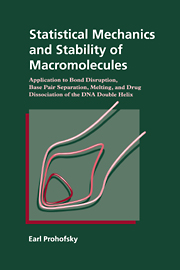 Statistical Mechanics and Stability of Macromolecules
Statistical Mechanics and Stability of Macromolecules Book contents
- Frontmatter
- Contents
- Preface
- 1 Introduction
- 2 Macromolecular stability
- 3 Lattice dynamics
- 4 Effective phonon theory
- 5 Premelting disrupted chemical bonds
- 6 Cooperative melting
- 7 Strained chemical bonds: salt and pressure effects
- 8 Bond disruption and conformation change: B to Z conformation change in DNA
- 9 Hydration effects: structural water
- 10 Helix with daunomycin intercalated: increased helix stability and daunomycin-DNA binding constant
- 11 Nonrepeating DNA
- 12 Cutting and splicing: junctions, inserts, and the replicating fork
- 13 Interaction between a helix and a single attached molecule
- 14 Energy considerations in bond opening
- Appendix 1 Helical lattice dynamics
- Appendix 2 Density matrix and effective phonon theory
- Appendix 3 Green functions
- References
- Index
9 - Hydration effects: structural water
Published online by Cambridge University Press: 16 September 2009
- Frontmatter
- Contents
- Preface
- 1 Introduction
- 2 Macromolecular stability
- 3 Lattice dynamics
- 4 Effective phonon theory
- 5 Premelting disrupted chemical bonds
- 6 Cooperative melting
- 7 Strained chemical bonds: salt and pressure effects
- 8 Bond disruption and conformation change: B to Z conformation change in DNA
- 9 Hydration effects: structural water
- 10 Helix with daunomycin intercalated: increased helix stability and daunomycin-DNA binding constant
- 11 Nonrepeating DNA
- 12 Cutting and splicing: junctions, inserts, and the replicating fork
- 13 Interaction between a helix and a single attached molecule
- 14 Energy considerations in bond opening
- Appendix 1 Helical lattice dynamics
- Appendix 2 Density matrix and effective phonon theory
- Appendix 3 Green functions
- References
- Index
Summary
Anomalous stability of poly(dA)–poly(dT)
The four DNA bases come in two sizes. The larger bases, adenine and guanine, are variants of the purine structure which is a double ring structure (Saenger, 1984). The smaller two bases, thymine and cytosine, are pyrimidine variants with a single ring. The base pairing scheme requires one purine and one pyrimidine in each pair making the total span the same for all complementary base pairs. The total molecular mass of the two pairs is almost identical as well. The difference in size makes the overlap of neighbor bases different in homopolymers compared to copolymers. In homopolymers a purine is stacked above another purine and pyrimidines above pyrimidines. The interbase gap undergoes helical twist but tends to be continuous, as seen in Figure 9–6 in Saenger (1984). In the copolymers the gap moves from one side of the twisting center line to the other depending on which side is the purine or which the pyrimidine. This shifting coupled with the helical twist in the copolymers causes considerable overlap of atoms of the large bases from one level to the next in every second base pair. The overlap is between bases on different strands in the copolymer and the van der Waals stacking interactions at the overlap becomes a cross strand interaction. The copolymer has these large interstrand interactions but the homopolymer does not. One would therefore expect that copolymers with this added cross strand interaction would be more stable against strand separation melting than homopolymers.
- Type
- Chapter
- Information
- Statistical Mechanics and Stability of MacromoleculesApplication to Bond Disruption, Base Pair Separation, Melting, and Drug Dissociation of the DNA Double Helix, pp. 127 - 136Publisher: Cambridge University PressPrint publication year: 1995
